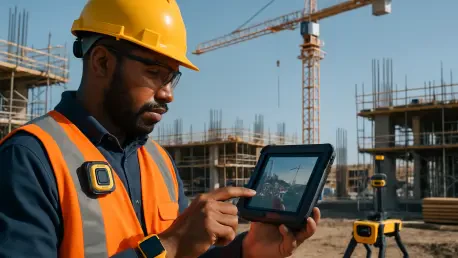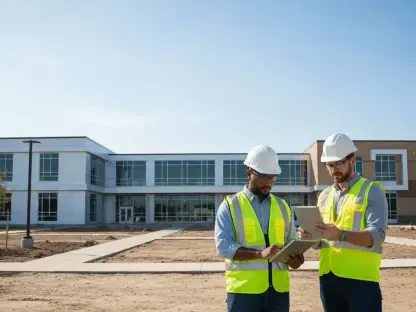In the construction industry, where danger lurks around every corner with risks like falls, machinery mishaps, and exposure to toxic environments, the safety of workers has never been more critical, as thousands of injuries and fatalities occur annually, painting a stark picture of the hazards faced daily. Amidst these challenges, a powerful force is emerging to rewrite the narrative—technology. Cutting-edge innovations are stepping onto the scene, offering tools and systems that not only protect lives but also streamline operations on construction sites worldwide. The urgency of this transformation is underscored by striking figures: the global market for construction worker safety, valued at $3.2 billion in 2024, is projected to soar to $4.6 billion by 2030, fueled largely by technological advancements. Beyond mere compliance with regulations, there’s a growing realization that safety is about fostering a culture where workers feel secure and valued. This article delves into how digital tools, smart equipment, and innovative training methods are revolutionizing safety practices, shifting the focus from reacting to incidents to preventing them altogether, and paving the way for a future where protection is embedded in every aspect of the job.
Digital Innovations Reshaping Safety Protocols
Harnessing AI and Predictive Analytics
The integration of artificial intelligence (AI) into construction safety marks a significant leap forward in managing on-site risks. AI-driven systems meticulously analyze historical accident data to forecast potential hazards, empowering site managers to implement preventive measures before issues escalate. Real-time monitoring, facilitated by drones and smart cameras, complements these efforts by providing instant oversight of site conditions, ensuring adherence to safety guidelines. This technology identifies risky behaviors or environmental threats as they unfold, allowing for swift interventions. The predictive nature of AI, combined with live surveillance, transforms safety management from a reactive process into a proactive strategy, significantly reducing the likelihood of accidents and fostering a more secure working environment for all involved.
Another dimension of AI’s impact lies in its ability to customize safety protocols based on specific site dynamics. By processing vast amounts of data, these systems can pinpoint unique risk patterns tied to particular projects or locations, enabling tailored solutions. For instance, high-traffic areas or zones prone to equipment failures can be flagged for extra vigilance. Additionally, cloud-based integration ensures that insights and alerts are accessible to all relevant personnel, no matter their location on-site. This seamless flow of information enhances coordination among teams, ensuring that safety remains a collective priority. As AI continues to evolve, its role in anticipating and mitigating dangers promises to become even more integral to construction operations.
Building Smarter Sites with BIM and Digital Twins
Building Information Modeling (BIM) and digital twins are redefining how safety is planned and executed in construction projects. These advanced digital platforms create detailed virtual replicas of sites, allowing teams to identify potential hazards during the design phase rather than after construction begins. By simulating various scenarios, such as structural weaknesses or crowded work zones, planners can address risks before they manifest in the real world. This preemptive approach minimizes surprises during active projects, ensuring that safety considerations are baked into every stage of development. The precision offered by these tools is proving invaluable in creating environments where dangers are anticipated and neutralized early.
Moreover, the use of cloud-based systems alongside BIM and digital twins enhances centralized control over safety protocols. These platforms enable real-time updates and data sharing across teams, ensuring that everyone—from architects to on-site workers—has access to the latest safety plans and hazard alerts. This connectivity reduces miscommunication, a common cause of accidents, and allows for immediate adjustments when new risks emerge. The ability to visualize and manage safety in a unified digital space not only boosts efficiency but also builds confidence among workers, who can trust that potential threats have been thoroughly assessed. As adoption of these technologies grows, their impact on reducing on-site incidents continues to gain momentum.
Advancements in Protective Gear and Automation
Next-Level Personal Protective Equipment (PPE)
Personal protective equipment (PPE) is undergoing a high-tech overhaul, dramatically enhancing worker protection on construction sites. Smart helmets equipped with hazard alerts and augmented reality displays provide real-time warnings and visual guidance, helping workers navigate complex environments safely. High-visibility clothing embedded with LED lighting ensures individuals remain seen, even in dim or foggy conditions, addressing a critical risk factor in many accidents. With the PPE market projected to reach $2.1 billion by 2030, these innovations are not just gadgets but essential tools that directly reduce injury rates. Their integration into daily operations signals a broader shift toward prioritizing safety through technology.
Beyond visibility and alerts, modern PPE is designed to adapt to the specific challenges of construction work. For example, gear now incorporates lightweight, durable materials that offer protection without hindering mobility, a crucial balance for workers performing physically demanding tasks. Some equipment even features built-in communication systems, allowing instant contact with supervisors during emergencies. This added layer of connectivity can mean the difference between a minor incident and a major crisis. As these technologies become more accessible and affordable, their widespread adoption is poised to set new benchmarks for what constitutes standard safety gear in the industry.
Wearables for Health and Safety Monitoring
Wearable technology is taking construction safety to a deeper level by focusing on the health and well-being of workers in real time. Devices equipped with fall-detection systems instantly alert supervisors if a worker experiences a sudden drop, enabling rapid response to potentially life-threatening situations. Biometric sensors embedded in safety gear monitor vital signs, detecting early signs of heat stress or exhaustion before they escalate into serious health issues. This proactive approach to physical health, combined with growing attention to mental well-being, reflects a holistic view of worker safety that goes beyond traditional protective measures and addresses the full spectrum of on-site risks.
The data collected by wearables also offers long-term benefits for safety management. By analyzing trends in health metrics, companies can identify patterns—such as frequent fatigue in certain roles or conditions—and adjust schedules or workloads accordingly. This not only prevents individual incidents but also informs broader safety policies, creating a feedback loop of continuous improvement. Furthermore, the integration of alerts into centralized systems ensures that supervisors are always informed, even across large or complex sites. As wearable tech becomes more sophisticated, its role in safeguarding workers’ health promises to expand, making it a cornerstone of modern construction safety strategies.
Minimizing Human Exposure to Danger Through Automation
Automation and robotics are fundamentally changing the risk landscape in construction by reducing the need for human involvement in dangerous tasks. Machines now handle high-risk activities such as demolition, heavy lifting, or dealing with hazardous materials, significantly lowering the chance of injury from human error or exposure. Drones, too, contribute by inspecting elevated or hard-to-reach areas, eliminating the need for workers to navigate precarious positions. This shift toward mechanized solutions is proving to be a critical step in creating safer work environments, as it directly tackles some of the most common causes of on-site accidents.
The adoption of automation also brings scalability to safety efforts. Robotic systems can operate continuously without the fatigue that affects human workers, ensuring consistent performance in hazardous conditions. Additionally, these technologies often come equipped with advanced sensors that detect environmental changes, such as unstable structures or toxic leaks, further reducing risks. As companies invest in these solutions, the cost of implementation is offset by the long-term savings from fewer accidents and improved project timelines. The growing reliance on automation highlights a future where human workers can focus on skilled tasks while machines handle the most perilous duties.
Enhancing Precision and Safety with Robotics
Beyond simply removing workers from harm’s way, robotics and automation enhance safety through unparalleled precision in executing tasks. Automated systems follow exact protocols without deviation, minimizing mistakes that often lead to accidents in manual operations. For instance, robotic equipment can perform repetitive or complex actions—like precise cutting or welding—with accuracy that reduces the risk of structural failures. This reliability ensures that safety standards are consistently met, providing a level of assurance that manual processes sometimes lack, and paving the way for more secure construction practices.
The ripple effects of this precision extend to overall site management. Automated tools generate detailed logs of their operations, offering data that can be analyzed to refine safety protocols further. This information helps identify inefficiencies or recurring risks tied to specific tasks, allowing for targeted improvements. Moreover, the integration of robotics with other digital systems, such as AI monitoring, creates a cohesive safety network where every element works in tandem. As these technologies become more mainstream, their ability to deliver both safety and operational benefits positions them as indispensable assets in the modern construction landscape.
Training and Cultural Evolution Through Tech
Virtual Reality for Real-World Preparedness
Virtual reality (VR) is revolutionizing training in the construction industry by offering immersive, risk-free environments where workers can hone their skills. Through VR simulations, employees practice responding to dangerous scenarios—such as equipment failures or sudden falls—without facing real-world consequences. This hands-on experience builds confidence and sharpens decision-making under pressure, directly translating to fewer mistakes on actual sites. By replicating the complexities of construction environments, VR ensures that workers are better prepared for the unpredictable nature of their jobs, marking a significant advancement in safety education.
The scalability of VR training also makes it a game-changer for large teams or remote locations. Digital simulations can be accessed anywhere, allowing consistent training standards across multiple sites, regardless of geographic barriers. Additionally, these programs can be updated to reflect the latest safety protocols or site-specific challenges, ensuring relevance. The data gathered from VR sessions provides insights into individual performance, helping trainers identify areas for improvement. As VR technology becomes more affordable, its adoption is likely to expand, solidifying its role as a critical tool in reducing on-site accidents through better-prepared workers.
Fostering a Safety-First Mindset Digitally
Technology is not just about tools but also about shaping attitudes, with digital platforms playing a key role in building a safety-first culture. Incident logging systems and behavior tracking apps encourage accountability by documenting near-misses and violations, creating a transparent record that promotes adherence to protocols. These platforms often integrate with training modules, reinforcing the importance of safety through regular education and reminders. By making safety a visible, measurable priority, companies are shifting mindsets, ensuring that workers view protective measures as integral to their roles rather than as mere obligations.
This cultural transformation is further supported by incentives tied to tech-driven safety programs. Insurance providers and regulatory bodies often offer benefits or reduced penalties to firms that adopt advanced systems, aligning financial gains with safety outcomes. Digital dashboards also allow workers to see how their actions contribute to overall site safety, fostering a sense of shared responsibility. Unlike traditional methods, which often rely on top-down enforcement, these tech solutions empower individuals at every level to engage actively in safety efforts. The result is a more cohesive, motivated workforce committed to protecting one another through informed, tech-supported practices.
Global Trends and Economic Impacts
Technology Driving a Booming Safety Market
The global emphasis on construction safety, propelled by technological innovation, is driving remarkable market expansion. From a valuation of $3.2 billion in 2024, the sector is expected to reach $4.6 billion by 2030, reflecting substantial investments in tech solutions like AI, robotics, and smart PPE. This growth is particularly pronounced in regions like China, where an annual growth rate of 9.5% signals a surge in demand fueled by rapid urbanization and infrastructure projects. The numbers highlight a clear trend: technology is not just an option but a necessity in addressing the urgent safety needs of a high-risk industry on a worldwide scale.
Behind these figures lies a deeper story of transformation. Investments in safety tech are often spurred by the high cost of accidents—medical expenses, legal liabilities, and lost productivity—that can cripple companies financially. Advanced systems offer a return on investment through fewer incidents and improved efficiency, making them attractive even in budget-conscious markets. Furthermore, as technology scales, costs are expected to decrease, broadening access to smaller firms. This democratization of safety solutions ensures that the benefits of innovation reach diverse corners of the industry, amplifying their impact on global worker protection.
Adapting to Regional Needs with Tech Solutions
While the push for tech-driven safety is universal, its application varies widely across regions, reflecting diverse challenges and opportunities. In the U.S., valued at $878.5 million in 2024, advanced systems like AI monitoring and digital twins are already standard in many projects, supported by stringent regulations. Meanwhile, emerging markets in Asia-Pacific and Latin America are rapidly adopting these technologies, driven by booming construction sectors and the need to meet growing safety demands. Tailoring tech to local conditions—such as limited resources or unique environmental risks—ensures that solutions remain effective regardless of geography.
This regional adaptability also highlights the role of collaboration in advancing safety. International standards and knowledge-sharing initiatives help align practices, even as specific tools are customized for local use. For instance, portable wearable tech proves invaluable in remote areas with limited infrastructure, while urban sites might prioritize drone surveillance. The ability to scale and modify tech solutions fosters resilience in safety efforts, addressing disparities in enforcement or funding. As global construction activity intensifies, the flexible application of technology promises to create a more uniformly safe industry, bridging gaps between developed and developing markets.
Reflecting on Tech’s Role in Safer Worksites
Looking back, the journey of construction safety reveals a profound shift, as persistent dangers once accepted as part of the trade are now met head-on with groundbreaking technological solutions. Innovations like AI analytics, robotics, and VR training have reshaped how risks are managed, turning reactive responses into proactive prevention. The market’s climb from $3.2 billion in 2024 to a projected $4.6 billion by 2030 mirrors the industry’s commitment to integrating these tools, while smart PPE and automation directly tackle the root causes of injuries. Moving forward, the focus should center on broadening access to these technologies, especially in under-resourced regions, through partnerships and cost-effective scaling. Additionally, sustaining the cultural shift toward safety-first mindsets requires ongoing investment in training and digital platforms that empower workers. The path ahead lies in balancing tech advancements with human-centric strategies, ensuring that every construction site, regardless of location, becomes a bastion of protection and efficiency for its workforce.









